You'll need seven essential tools to test your handcrafted perfumes like a pro: perfume testing strips for scent evaluation, precise digital scales for measurements, glass containers for pure storage, temperature controls for a stable environment, olfactory cleansing equipment to reset your nose, natural lighting for color verification, and documentation tools to track your progress. Master these fundamentals, and you'll reveal the secrets to consistently producing high-quality fragrances that meet professional standards.
Essential Testing Strips and Blotters for Scent Analysis
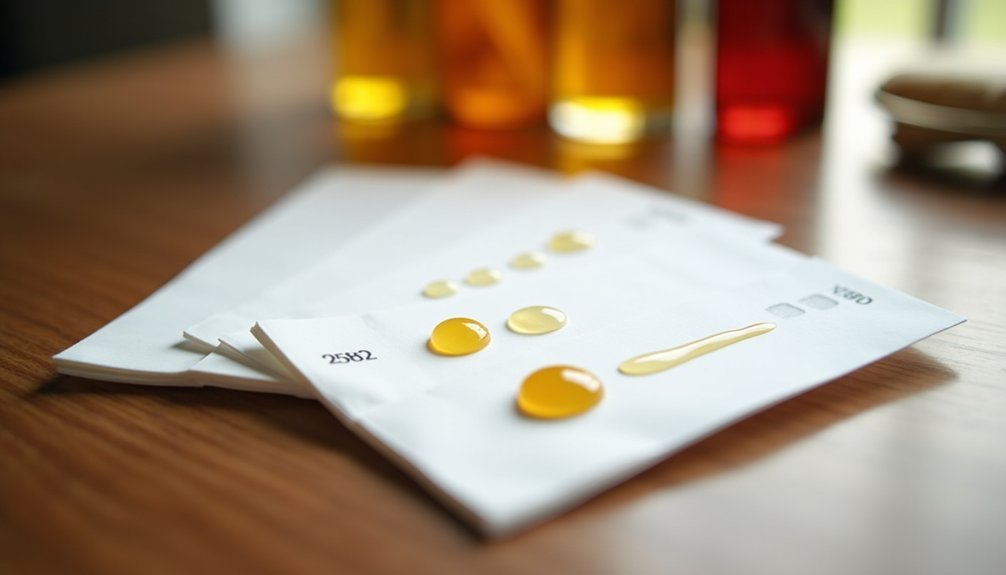
Perfume testing strips serve as your gateway to properly evaluating fragrances without the interference of skin chemistry.
These eco-friendly tools, crafted from premium paper and soy ink, offer superior absorption for both essential oils and water-based perfumes, ensuring accurate scent assessment.
To get the most reliable results, you'll want to bend the strip's end upward and spray downward, preventing direct contact with the testing surface.
When conducting your evaluation, limit yourself to testing three fragrances at a time to maintain sensory accuracy.
You can keep your testing strips for future reference, which lets you track how scents evolve over time and compare different fragrances effectively.
This systematic approach helps you develop a thorough understanding of your perfume collection's characteristics.
Digital Scales and Precise Measurement Tools
To guarantee your digital scale maintains its accuracy, you'll need to calibrate it regularly using certified weights and clean the weighing platform thoroughly with ethanol.
When working with small fragrance quantities, you'll achieve the most precise measurements by using a scale with 0.01-gram precision and glass measuring cylinders that are specifically designed for perfumery.
For best results, remember to check your scale's accuracy before each use and keep a log of calibration dates to maintain consistent quality in your perfume formulations.
Scale Calibration Best Practices
Accurate scale calibration stands at the heart of successful perfume creation. Unlike testing different scents at department stores, crafting perfumes requires precise measurements that only a well-calibrated scale can provide.
You'll need to use certified calibration weights regularly to guarantee your measurements remain exact and consistent.
Before weighing your ingredients, place your scale on a stable surface and let it warm up for several minutes. Always tare your scale with your measuring container to eliminate any weight discrepancies.
For the best results, choose a digital scale with 0.01-gram readability, especially when working with concentrated essential oils.
Keep your scale clean by wiping the weighing surface with a soft cloth, and avoid harsh chemicals that could compromise its accuracy or contaminate future measurements.
Measuring Small Fragrance Quantities
When working with small fragrance quantities, having the right set of measuring tools makes the difference between a successful blend and a costly mistake.
You'll need a digital scale that's properly calibrated to guarantee accurate measurements of your fragrance ingredients.
Use glass measuring cylinders and beakers for mixing your essential and fragrance oils – they're ideal for maintaining hygiene and precision during the blending process.
Don't forget to keep a thermometer handy when your recipe requires specific temperature conditions.
For transferring tiny amounts of liquids and testing scents, disposable plastic pipettes are your best choice as they prevent cross-contamination.
Before you begin measuring, always sterilize your equipment with ethanol.
This vital step maintains ingredient integrity and prevents unwanted chemical reactions that could affect your final perfume quality.
Professional Glass Storage and Sampling Containers
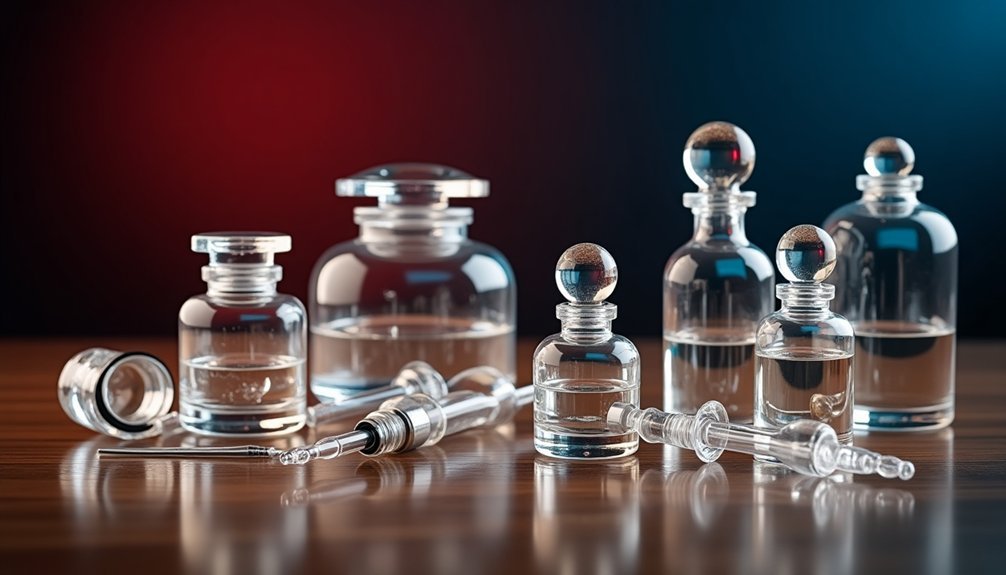
Professional glass containers form the backbone of reliable perfume testing and storage. You'll find that glass's inert properties prevent unwanted chemical reactions, guaranteeing your fragrances remain pure and uncontaminated during testing and storage periods.
Before using your containers, you'll need to sterilize them thoroughly to eliminate any potential pollutants that could compromise your perfume's composition.
When selecting your glass containers, look for designs that combine functionality with aesthetic appeal – they'll not only protect your fragrances but also enhance your brand presentation during testing sessions.
Choose clear glass containers with reliable sealing mechanisms. They'll let you visually inspect your perfume's color and clarity while preventing evaporation and oxidation.
This combination of features guarantees accurate, consistent testing results and maintains your fragrance's integrity over time.
Temperature-Controlled Testing Environment Setup
Since temperature fluctuations can drastically alter a perfume's fragrance profile, establishing a controlled testing environment becomes essential for reliable quality assessment.
You'll need to maintain temperatures between 20°C to 22°C (68°F to 72°F) while keeping humidity levels at 40-50% for ideal testing conditions.
- Feel confident in your assessments by using a digital thermometer to monitor and adjust your testing space with precision.
- Experience the true essence of each fragrance in a well-ventilated area that prevents nasal fatigue.
- Trust your evaluations knowing that consistent temperatures protect the integrity of volatile compounds.
- Protect your valuable creations from degradation by maintaining proper humidity levels that prevent mold growth.
Install proper air conditioning and heating systems to maintain these conditions, ensuring your testing environment delivers accurate, reliable results every time.
Olfactory Cleansing and Recovery Equipment
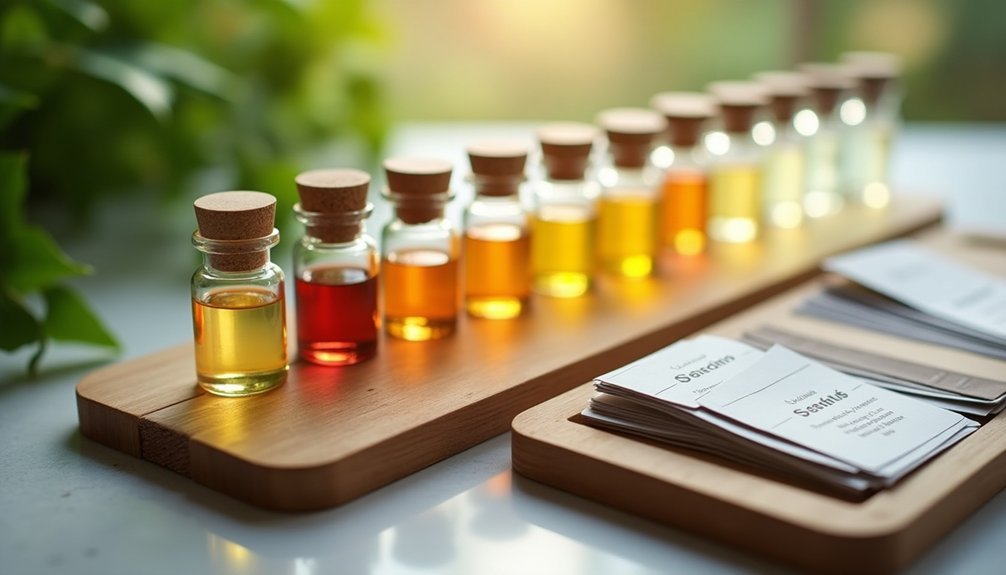
To maintain peak olfactory sensitivity during perfume testing, proper cleansing and recovery equipment proves indispensable. You'll want to skip the traditional coffee beans and opt for more effective tools that help reset your nose between scents.
| Equipment | Purpose |
|---|---|
| Personal Fabric Swatch | Use your own unscented clothing to reset nose |
| Timer | Track breaks between testing 3 scents |
| Clean Elbow Cover | Breathe into for quick sensory reset |
| Scent-Free Room Filter | Maintain neutral testing environment |
Keep your testing environment equipped with these essential tools to maximize accuracy. You'll need to verify proper ventilation and maintain a clean space free from competing aromas. Don't forget to incorporate regular breaks using your chosen cleansing method, and you'll maintain ideal sensitivity throughout your fragrance evaluation process.
Natural Light Sources for Color Assessment
Position your perfume testing station near a window with sheer curtains to achieve ideal diffused natural light for color assessment.
You'll want to examine your handcrafted fragrances during daylight hours when the sun's position allows for even illumination without harsh direct exposure.
For the most accurate color verification, hold your perfume bottles at eye level against a white background while utilizing the filtered sunlight through your chosen window position.
Window Positioning Matters
When evaluating perfume quality, proper window placement of your testing station can make all the difference in achieving accurate color assessments.
You'll want to position your workspace near windows that receive consistent natural light throughout the day, as this reveals subtle color variations and potential impurities that artificial lighting might miss.
- Your testing accuracy directly impacts the quality of your final product
- You're ensuring professional standards with every batch evaluation
- You'll catch subtle imperfections before they reach your customers
- You're maintaining the artisanal integrity of your craft
Always use a white or neutral background when examining your perfumes, as this enhances contrast and provides clearer visibility.
Remember to test your fragrances at different times of day, since changing sunlight angles can affect how you perceive color.
Keep your testing station fixed in the same window location to maintain consistent evaluation conditions.
Sunlit Color Verification
Natural sunlight provides three essential advantages for perfume color verification that artificial lighting simply can't match. You'll get true color representation, consistent evaluation conditions, and the ability to detect subtle quality indicators that might otherwise go unnoticed.
| Testing Element | Natural Light | Artificial Light |
|---|---|---|
| Color Accuracy | True hues | Distorted tones |
| Consistency | North window | Variable output |
| Quality Check | Clear details | Hidden features |
To maximize your assessment accuracy, position your perfume near a north-facing window during daylight hours. Place your bottle against a white background to enhance visibility and catch any color variations. Don't forget to document your observations regularly – this practice helps you track changes over time and understand how your perfume ages. These careful measurements can reveal important details about ingredient stability and overall quality.
Documentation Tools for Fragrance Evolution
The meticulous documentation of fragrance evolution stands as a cornerstone of quality perfume creation. You'll need both physical and digital tools to effectively track your perfume's development. Printed formulas on acid-free paper serve as your primary foundation, while handwritten notes capture vital real-time adjustments.
Precision in perfume making demands thorough documentation, blending time-tested paper records with modern digital tracking for complete creative control.
- Feel confident knowing your unique creations are preserved for future generations
- Experience peace of mind with secure archival of your proprietary formulas
- Take pride in maintaining professional consistency across all batches
- Embrace the satisfaction of watching your fragrance portfolio grow systematically
When you combine traditional documentation with digital backups, you're creating a robust system that protects your artistic work.
Store your finalized formulas in a secure location, ensuring that you can replicate your signature scents with precision whenever needed.
Frequently Asked Questions
How Do You Check the Quality of Perfume?
You'll want to check ingredients for natural oils, test wear time on your skin, evaluate the sillage's projection, use blotter papers, and allow several hours to experience how the fragrance develops fully.
What Is the Best Material to Test Perfume On?
You'll get the best perfume testing results using high-quality paper blotters (Mouillettes) for clean sampling, and your skin for real-world wear. Both methods let you evaluate how fragrances develop over time.
What Is the 30 50 20 Rule for Perfume?
The 30-50-20 rule guides you in perfume composition: you'll want 30% top notes for initial impact, 50% middle notes for the heart of your fragrance, and 20% base notes for lasting depth.
How to Check Authenticity of Perfume?
You'll want to check the packaging quality, inspect the bottle's craftsmanship, verify batch codes, evaluate the scent's complexity, and buy from authorized retailers to guarantee your perfume's authenticity. Don't trust unreliable sellers.
In Summary
You'll achieve consistent quality control in your handcrafted perfumes by regularly using these seven essential testing tools. Keep your workspace equipped with blotters, precise scales, proper storage, temperature controls, olfactory cleansers, natural lighting, and detailed documentation methods. As you refine your perfume-making process, these tools won't just verify quality – they'll help you create increasingly sophisticated and stable fragrances.
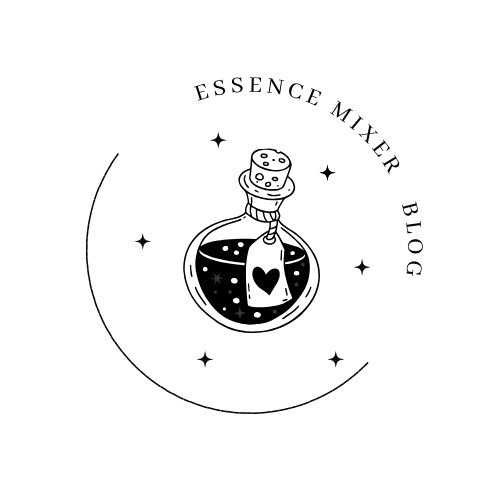
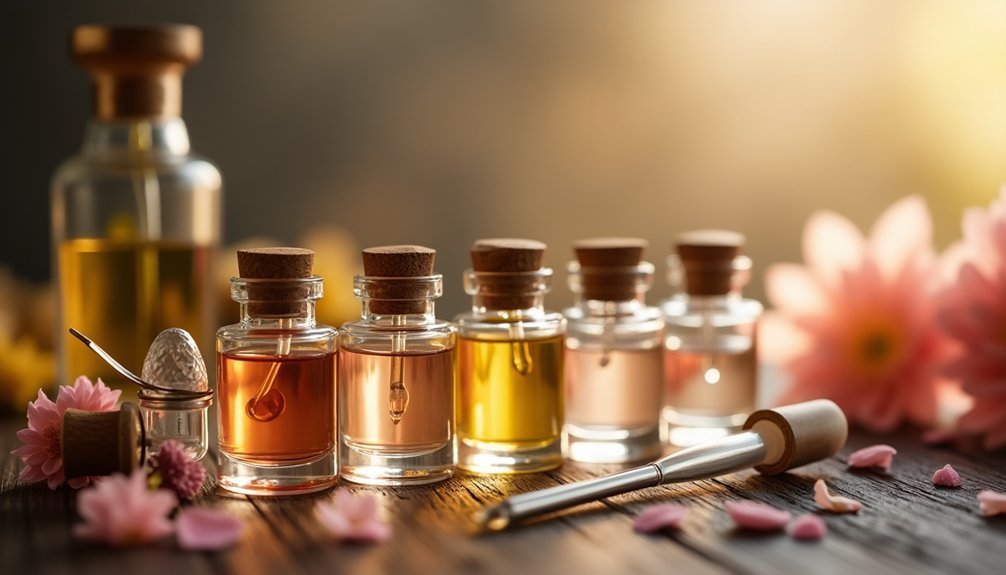



Leave a Reply